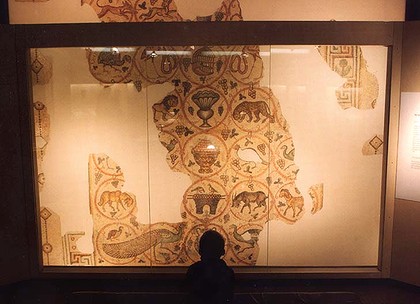Questions raised over 'looted' Byzantine mosaic
by Andrew Taylor
Sydney Morning Herald
smh.co.au
August 14, 2011
The Shellal Mosaic has been in the Australian War Memorial in
Canberra since 1941.

IN 1917, a Byzantine mosaic created during the reign of Emperor
Justinian was removed by Australian troops from the ruins of a church
near Gaza. The Australians knew they were plundering the priceless
antiquity during World War I, two authors now claim.
In a new book, authors Paul Daley, a Sun-Herald columnist, and
Michael Bowers, raise questions about Australia's continued possession
of the mosaic, which has been in the Australian War Memorial collection
since 1941.
''But from time to time, Australian authorities have privately
expressed their unease at the fact that the mosaic was effectively
looted from Palestine and removed to Australia, fearing it could
become the focus of the type of debate that surrounds Britain's
acquisition and 'safe keeping' of Greece's Elgin Marbles,'' Daley
writes in Armageddon, Two Men on an Anzac Trail.
The Shellal Mosaic was uncovered and significantly damaged by Turkish
soldiers while digging a machine gun position on a hill where the
Shellal Church had once stood, according to the War Memorial. Anzac
forces rediscovered the mosaic during the second battle of Gaza
in April 1917.
In the book Daley, who disagrees with the government's view that
not enough was known about the removal to determine if it was pillaged,
describes how impressed Australian military leaders were with the
find. In a letter to his wife, General Harry Chauvel wrote of the
discovery of ''a very handsome mosaic floor''. Major-General Granville
De Laune Ryrie wrote to his wife: ''It is done in different coloured
little square stones set on cement and is awfully well done …
the colours are very good, it would be worth a lot if it could be
moved.''
A leading legal expert said the removal of an antiquity was a crime
under international law.
''In a general sense [the soldiers] could be said to have violated
the laws and customs of war,'' said Emeritus Professor Ben Boer
from the University of Sydney's Law School. But Australia did not
appear to be bound by these laws in April 1917, he added.
Professor Boer also said international law did not require the
Australian government to return the Shellal Mosaic to its rightful
owner.
The question of whether Australia should return the Shellal Mosaic
is an ethical, not legal, one, he said. ''Should Australia return
the mosaic in recognition of its importance to the cultural heritage
of people of the region? However, it seems unlikely at this point
that there would be a demand for its return.''
International law prohibits pillage, and the seizure of the property
of institutions dedicated to the arts and sciences ''and breach
of these provisions would amount to a war crime'', the Department
of Foreign Affairs and Trade said.
However, it says that ''not enough is known about the circumstances
of the removal of the mosaic to say whether or not it constituted
pillage or seizure of property amounting to a war crime.''
A spokesman for Warren Snowdon, the Minister for Veterans' Affairs,
said the Shellal Mosaic's remains were removed in the belief that
it might be destroyed in future military action.
''The Australians who dug up the Shellal Mosaic knew its precise
value. The Palestinian Authority is said to have carefully considered
whether or not to seek some sort of formal acknowledgement from
Australia that the mosaic rightfully belongs to its people,'' he
said.
If there was such a request, then there could be a moral case for
returning it, Professor Boer said.
But it may be impossible to return the item intact because it now
forms part of a supporting wall.
''Because of its extreme fragility, any attempts to interfere with
the Mosaic or try to detach it … will likely lead to its permanent
damage,'' Mr Snowdon's spokesman said.
Read more: http://www.smh.com.au/national/questions-raised-over-looted-mosaic-20110813-1irra.html#ixzz1V0ABOe4c
|


